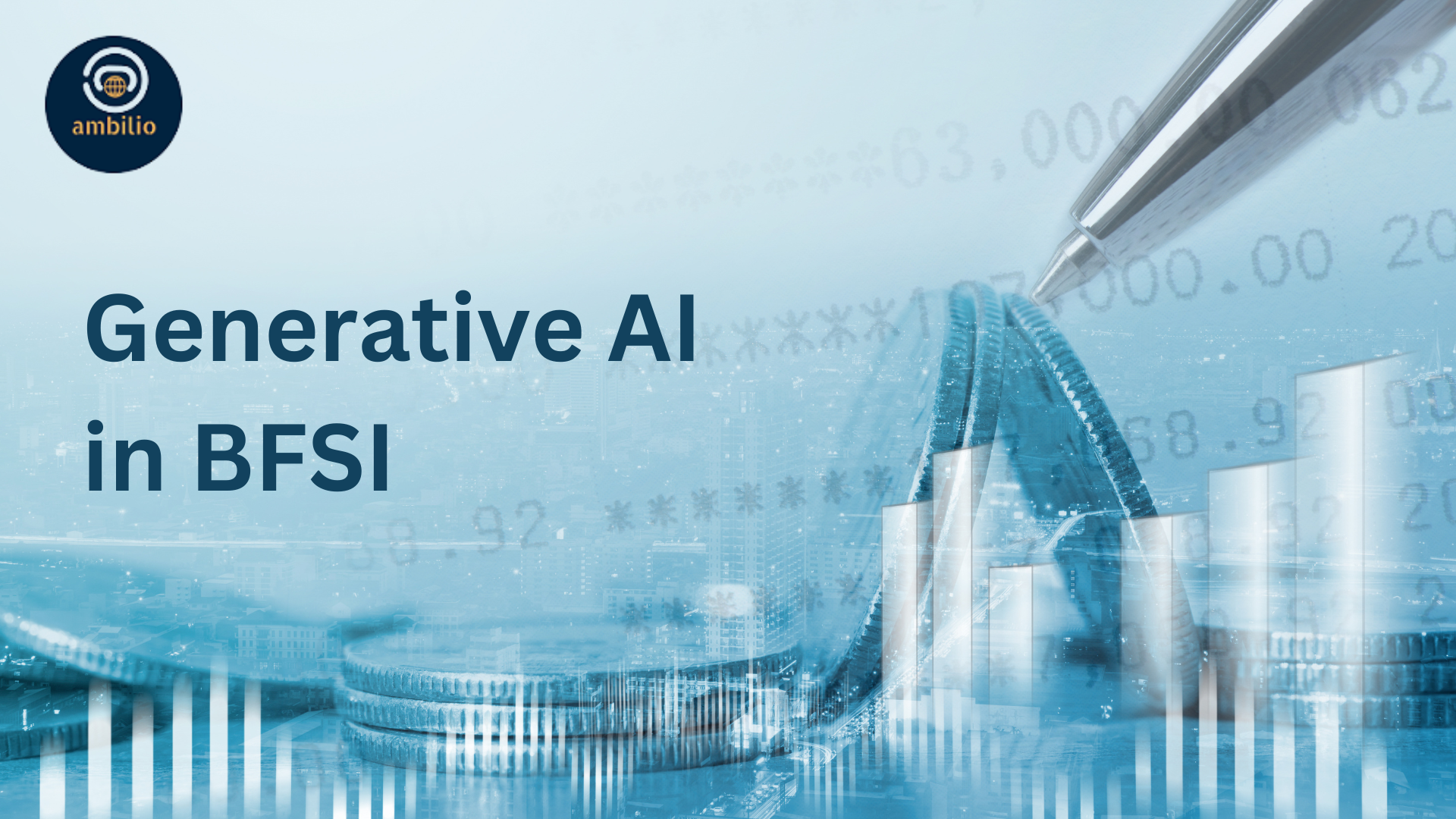Generative AI is being applied to different sectors for game-changing results. It can be used in the BFSI (Banking, Financial Services, and Insurance) sector as well. Generative AI algorithms can help BFSI companies to create more accurate and personalized financial models, identify fraudulent activities, and provide more customized investment recommendations. The use of generative AI in BFSI can lead to increased efficiency, better risk management, and improved customer satisfaction. Here we present our proposed use cases utilizing the power of generative AI in the BFSI sector.
What is Generative AI?
Generative AI refers to the use of machine learning algorithms to create new data, such as images, videos, or text, that is similar to the existing data that the algorithm has been trained on. This is in contrast to discriminative AI, which is focused on identifying patterns and relationships within existing data.
Generative AI has a number of applications in the context of advancing analytics and machine learning. For example, it can be used to augment or expand existing datasets, which can improve the performance of machine learning models. It can also be used to generate synthetic data, which can be used to train models in situations where real-world data is scarce or difficult to obtain.
Generative AI in BFSI
Generative AI, which involves using deep learning algorithms to generate new data based on patterns learned from existing data, has the potential to significantly improve various areas in the banking, financial services, and insurance (BFSI) sector. Some of the application areas in BFSI where generative AI can show significant improvements include:
Fraud Detection
Generative AI can help detect fraudulent activities by generating synthetic data and comparing it to the actual data. It can identify patterns that may indicate fraudulent behavior and help financial institutions to develop more effective fraud detection models.
Risk Assessment
Generative AI can help predict risk by generating synthetic data based on historical data and simulating various scenarios to assess the probability of different outcomes. This can help financial institutions to make more informed decisions when assessing risks and developing risk management strategies.
Customer Service
Generative AI can help enhance customer service by generating personalized recommendations for products and services based on a customer’s financial history and preferences. This can help financial institutions to provide more targeted and effective services to their customers.
Portfolio Optimization
Generative AI can help financial institutions to optimize their investment portfolios by generating synthetic data and simulating various investment scenarios. This can help them to identify opportunities for diversification and develop more effective investment strategies.
Credit Scoring
Generative AI can help improve credit scoring models by generating synthetic data and training models on this data. This can help financial institutions to more accurately assess credit risk and make more informed lending decisions.
Use Cases: The Ways of Transformation
Use Case of Generative AI in BFSI: Synthetic Data for Modelling
The BFSI (Banking, Financial Services, and Insurance) industry deals with sensitive financial data of customers, and as such, privacy concerns limit the availability of real-world data for modelling purposes. In this scenario, the use of Generative AI can generate synthetic data that emulates the characteristics of real-world data while preserving the privacy of customers.
A detailed use case for the application of Generative AI in BFSI to generate synthetic data for modelling purposes involves the development of a credit-scoring model. Credit scoring models are used by financial institutions to evaluate the creditworthiness of individuals and businesses to determine their eligibility for loans or other financial services. To build a robust credit scoring model, a large and diverse dataset that covers various demographics, income levels, and credit histories is required.
The following steps can be taken to apply Generative AI to BFSI for credit scoring modelling purposes:
Data Collection: The first step involves collecting a sample of real-world data from a financial institution. The data should include relevant information such as demographic data, income data, employment data, loan history, and credit score history.
Data Preprocessing: Once the data has been collected, it must be preprocessed to ensure its quality and accuracy. This step includes data cleaning, data normalization, and data transformation.
Model Development: The next step involves developing a Generative AI model that can generate synthetic data that emulates real-world data. Various techniques such as Variational Autoencoders (VAEs), Generative Adversarial Networks (GANs), or Restricted Boltzmann Machines (RBMs) can be used to develop a Generative AI model. The model should be trained on the preprocessed data to generate synthetic data that emulates the characteristics of real-world data.
Synthetic Data Generation: The Generative AI model is then used to generate synthetic data that mimics the characteristics of real-world data while preserving the privacy of customers. The synthetic data should have similar distributions, correlations, and relationships as the real-world data.
Model Training and Evaluation: The synthetic data is then used to train a credit scoring model using traditional machine learning algorithms such as logistic regression, decision trees, or random forests. The model’s performance is then evaluated on a test dataset to ensure its accuracy and robustness.
Model Deployment: Once the credit scoring model is trained and validated, it can be deployed in a financial institution’s decision-making process to evaluate the creditworthiness of individuals and businesses.
In summary, Generative AI can be used in BFSI to generate synthetic data for modelling purposes such as credit scoring. The process involves collecting real-world data, preprocessing it, developing a Generative AI model, generating synthetic data, training and evaluating the credit scoring model, and finally deploying it in a financial institution’s decision-making process. Techniques such as VAEs, GANs, or RBMs can be used to develop Generative AI models.
Use Case of Generative AI in BFSI: Personalized Financial Planning
Generative AI can be used in BFSI (Banking, Financial Services, and Insurance) for personalized financial planning to help individuals manage their money better and achieve their financial goals. Here is a detailed use case where generative AI is applied to BFSI for personalized financial planning:
Data Collection
The first step is to gather financial data from the individual, including income, expenses, assets, and liabilities. The data can be collected through various sources such as bank statements, credit card statements, investment portfolios, and other financial documents.
Data Analysis
Once the data is collected, it needs to be analyzed to identify patterns, trends, and insights. The analysis can be done using machine learning algorithms, including regression analysis, clustering, and decision trees, to identify the individual’s spending habits, income, and investment preferences.
Goal Setting
After analyzing the data, the AI system can help the individual set financial goals based on their income, expenses, and investment preferences. These goals could be long-term goals such as retirement planning, short-term goals such as paying off a debt or saving for a down payment on a house, or mid-term goals such as building an emergency fund.
Plan Generation:
Once the financial goals are set, the generative AI system can generate personalized financial plans to achieve those goals. The plans may include recommendations on investment strategies, savings plans, debt reduction plans, and other financial decisions. The AI system can use various financial models and algorithms to generate the plans that are optimized for the individual’s financial goals, risk tolerance, and other financial factors.
Plan Optimization
The AI system can continuously monitor the individual’s financial data and adjust the financial plans to optimize the individual’s financial situation. For example, if the individual’s income or expenses change, the AI system can adjust the savings plan or investment strategy accordingly. The AI system can also suggest new financial plans if the individual’s financial goals or priorities change over time.
Personalized Recommendations
The AI system can provide personalized recommendations to individual based on their financial goals and preferences. For example, the system can suggest investment opportunities or savings plans that are aligned with the individual’s risk tolerance and investment preferences. The AI system can also provide personalized financial advice and insights to help the individual make informed financial decisions.
Conclusion
Generative AI can play a crucial role in BFSI by providing personalized financial planning services to individuals. The AI system can analyze financial data, set financial goals, generate financial plans, optimize plans, and provide personalized recommendations to help individuals achieve their financial goals. With the help of generative AI, individuals can manage their money better, make informed financial decisions, and achieve financial success.
Use Case of Generative AI in BFSI: Underwriting
Generative AI can be applied to BFSI (Banking, Financial Services, and Insurance) for underwriting, which involves assessing the risk of insuring a client or granting a loan to an individual or business. Here is a detailed use case where generative AI is applied to BFSI for underwriting:
Data Collection
The first step is to gather data from the individual or business applying for the insurance or loan. This data includes financial information, credit history, employment information, and other relevant information. The data can be collected through various sources, such as application forms, credit reports, bank statements, and other financial documents.
Data Analysis
Once the data is collected, it needs to be analyzed to assess the risk of insuring or lending to the individual or business. The analysis can be done using machine learning algorithms, including regression analysis, clustering, and decision trees, to identify patterns, trends, and insights in the data. The analysis can also include external data sources, such as social media and news feeds, to gain additional insights into the individual or business’s financial situation.
Risk Assessment
After analyzing the data, the generative AI system can assess the risk of insuring or lending to the individual or business. The system can use various risk assessment models and algorithms to determine the likelihood of default or other financial risks. The risk assessment can include a credit score, income verification, and other factors to determine the overall risk profile of the individual or business.
Underwriting Decision
Based on the risk assessment, the generative AI system can make an underwriting decision, such as approving or denying the insurance or loan application. The system can also suggest alternative underwriting strategies, such as offering a higher interest rate or requiring collateral, to mitigate the risk of lending or insuring the individual or business.
Continuous Monitoring
The generative AI system can continuously monitor the individual or business’s financial data to ensure that the risk assessment remains accurate over time. The system can also adjust the underwriting decision if there are significant changes in the individual or business’s financial situation.
Conclusion
Generative AI can play a crucial role in BFSI by providing accurate and efficient underwriting services. The AI system can analyze data, assess risk, make underwriting decisions, and continuously monitor the individual or business’s financial data. With the help of generative AI, BFSI companies can make informed underwriting decisions, mitigate risks, and ensure financial stability.



